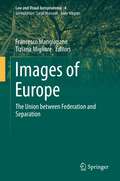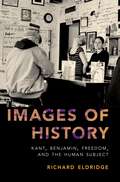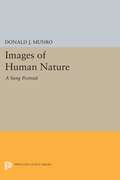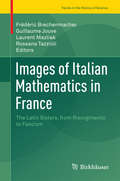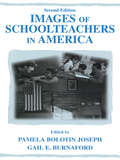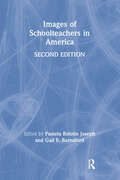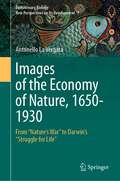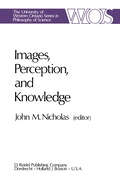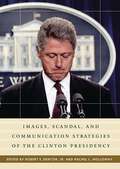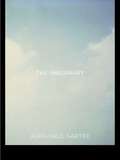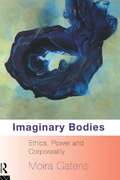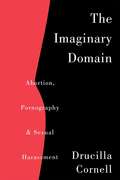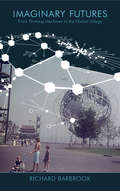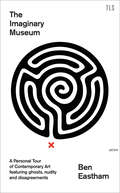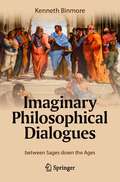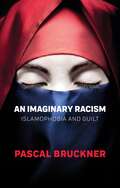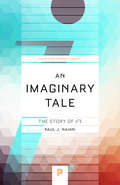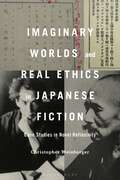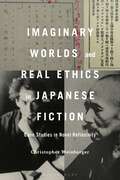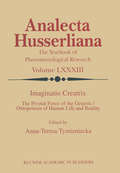- Table View
- List View
Images of Europe: The Union between Federation and Separation (Law and Visual Jurisprudence #4)
by Francesco Mangiapane Tiziana MiglioreThis book deals with the fundamental semantics of images of Europe, which consist of valences, mirror beliefs and affectivities. This is why it relaunches the importance of the European discourse in its symbolic dimension. As such, it explores the many images of Europe, or rather the many images through which European discourse is actually constituted in daily life, in search of their enunciative responsibility in today’s world for determining the current “State of the Union”. The identity of the European continent is based on a millenary tension between universalism and particularism: images of Europe have in fact been alternately inspired, over the centuries, by a model of homogeneity – Roman and Carolingian imperial disposition – on the one hand, and by a model of fragmentation – a Europe of city-states, municipalities, regions and small fatherlands – on the other. In the European Union, a political and economic organism, this issue has recently been amplified to the point that it has reentered public debate, and political parties that are only recognizable for being Europeanists or anti-Europeanists are now ubiquitous. In this regard, one major bone of contention is how to portray the quintessential aspects of the European territory, which are either interpreted as “thresholds” to be overcome in the name of a model of United Europe – “integral totality” – or are instead regarded as insurmountable obstacles for a Europe that is irreparably and perhaps, according to anti-Europeanists, fortunately fragmented – “partitive totality”. Further, this is to be done without excluding the possibility of contradictory and complementary solutions to these binary visions. In this context the book analyzes various texts in order to obtain a more precise picture of the clash, reveal its semiotic forms, and by doing so, identify a way out of the crisis.
Images of History: Kant, Benjamin, Freedom, and the Human Subject
by Richard EldridgeDeveloping work in the theories of action and explanation, Eldridge argues that moral and political philosophers require accounts of what is historically possible, while historians require rough philosophical understandings of ideals that merit reasonable endorsement. Both Immanuel Kant and Walter Benjamin recognize this fact. Each sees a special place for religious consciousness and critical practice in the articulation and revision of ideals that are to have cultural effect, but they differ sharply in the forms of religious-philosophical understanding, cultural criticism, and political practice that they favor. Kant defends a liberal, reformist, Protestant stance, emphasizing the importance of liberty, individual rights, and democratic institutions. His fullest picture of movement toward a moral culture appears in Religion within the Bounds of Mere Reason, where he describes conjecturally the emergence of an ethical commonwealth. Benjamin defends a politics of improvisatory alertness and consciousness-raising that is suspicious of progress and liberal reform. He practices a form of modernist, materialist criticism that is strongly rooted in his encounters with Kant, Hölderlin, and Goethe. His fullest, finished picture of this critical practice appears in One-Way Street, where he traces the continuing force of unsatisfied desires. By drawing on both Kant and Benjamin, Eldridge hopes to avoid both moralism (standing on sharply specified normative commitments at all costs) and waywardness (rejecting all settled commitments). And in doing so, he seeks to make better sense of the commitment-forming, commitment-revising, anxious, reflective and sometimes grownup acculturated human subjects we are.
Images of History: Kant, Benjamin, Freedom, and the Human Subject
by Richard EldridgeDeveloping work in the theories of action and explanation, Eldridge argues that moral and political philosophers require accounts of what is historically possible, while historians require rough philosophical understandings of ideals that merit reasonable endorsement. Both Immanuel Kant and Walter Benjamin recognize this fact. Each sees a special place for religious consciousness and critical practice in the articulation and revision of ideals that are to have cultural effect, but they differ sharply in the forms of religious-philosophical understanding, cultural criticism, and political practice that they favor. Kant defends a liberal, reformist, Protestant stance, emphasizing the importance of liberty, individual rights, and democratic institutions. His fullest picture of movement toward a moral culture appears in Religion within the Bounds of Mere Reason, where he describes conjecturally the emergence of an ethical commonwealth. Benjamin defends a politics of improvisatory alertness and consciousness-raising that is suspicious of progress and liberal reform. He practices a form of modernist, materialist criticism that is strongly rooted in his encounters with Kant, Hölderlin, and Goethe. His fullest, finished picture of this critical practice appears in One-Way Street, where he traces the continuing force of unsatisfied desires. By drawing on both Kant and Benjamin, Eldridge hopes to avoid both moralism (standing on sharply specified normative commitments at all costs) and waywardness (rejecting all settled commitments). And in doing so, he seeks to make better sense of the commitment-forming, commitment-revising, anxious, reflective and sometimes grownup acculturated human subjects we are.
Images of Human Nature: A Sung Portrait
by Donald J. MunroIn this volume Donald Munro, author of important studies on early and contemporary China, provides a critical analysis of the doctrines of the Sung Neo-Confucian philosopher Chu Hsi (1130-1200). For nearly six centuries Confucian orthodoxy was based on Chu Hsi's commentaries on Confucian classics. These commentaries were the core of the curriculum studied by candidates for the civil service in China until 1905 and provided guidelines both for personal behavior and for official policy. Munro finds the key to the complexities of Chu Hsi's thought in his mode of discourse: the structural images of family, stream of water, mirror, body, plant, and ruler. Furthermore, he discloses the basic framework of Chu Hsi's ethics and the theory of human nature that is provided by these illustrative images.As revealed by Munro, Chu Hsi's thought is polarized between family duty and a broader altruism and between obedience to external authority and self-discovery of moral truth. To understand these tensions moves us toward clarifying the meaning of each idea in the sets. The interplay of these ideas, selectively emphasized over time by later Confucians, is a background for explaining modern Chinese thought. In it, among other things, Confucianism and Marxism-Leninism co-exist.Originally published in 1988.The Princeton Legacy Library uses the latest print-on-demand technology to again make available previously out-of-print books from the distinguished backlist of Princeton University Press. These editions preserve the original texts of these important books while presenting them in durable paperback and hardcover editions. The goal of the Princeton Legacy Library is to vastly increase access to the rich scholarly heritage found in the thousands of books published by Princeton University Press since its founding in 1905.
Images of Italian Mathematics in France: The Latin Sisters, from Risorgimento to Fascism (Trends in the History of Science)
by Frédéric Brechenmacher Guillaume Jouve Laurent Mazliak Rossana TazzioliThe contributions in this proceedings volume offer a new perspective on the mathematical ties between France and Italy, and reveal how mathematical developments in these two countries affected one another. The focus is above all on the Peninsula’s influence on French mathematicians, counterbalancing the historically predominant perception that French mathematics was a model for Italian mathematicians. In the process, the book details a subtle network of relations between the two countries, where mathematical exchanges fit into the changing and evolving framework of Italian political and academic structures. It reconsiders the issue of nationalities in all of its complexity, an aspect often neglected in research on the history of mathematics. The works in this volume are selected contributions from a conference held in Lille and Lens (France) in November 2013 on Images of Italian Mathematics in France from Risorgimento to Fascism. The authors include respected historians of mathematics, philosophers of science, historians, and specialists for Italy and intellectual relations, ensuring the book will be of great interest to their peers.
Images of Schoolteachers in America
by Pamela Bolotin Joseph Gail E. BurnafordThis book explores images of schoolteachers in America from the beginning of the 20th century to the present, using a wide range of approaches to scholarship and writing. It is intended for both experienced and aspiring teachers to use as a springboard for discussion and reflection about the teaching profession and for contemplating these questions: What does it mean to be a teacher? What has influenced and sustained our beliefs about teachers? New in the second edition * The focus is shifted to the teaching profession as the 21st century unfolds. * The volume continues to explore teacher images through various genres--oral history, narrative, literature, and popular culture. In the second edition, the authors place more emphasis on the social-political context that has shaped teachers' daily experiences and the teaching profession itself. In the study of teacher images and schooling, the essays draw from feminist research methods and the critical tradition in educational inquiry to probe issues of power and authority, race, social class, and gender. * The emphasis is on the multidimensionality of teacher images rather than normative characterizations. * Six totally new chapters have been written for this new edition: an "invented interview" spanning 100 years of school teaching; portraits of progressive activist teachers; an exploration of teachers in fiction for young adults; a retrospective of the satirical cartoon show, The Simpsons; a study of crusading and caring teachers in films; and an overview of progressive classroom practices in "the new millennium." Seven chapters have been thoroughly revised to reflect current scholarship and the authors' evolving knowledge and interests.
Images of Schoolteachers in America
by Pamela Bolotin Joseph Gail E. BurnafordThis book explores images of schoolteachers in America from the beginning of the 20th century to the present, using a wide range of approaches to scholarship and writing. It is intended for both experienced and aspiring teachers to use as a springboard for discussion and reflection about the teaching profession and for contemplating these questions: What does it mean to be a teacher? What has influenced and sustained our beliefs about teachers? New in the second edition * The focus is shifted to the teaching profession as the 21st century unfolds. * The volume continues to explore teacher images through various genres--oral history, narrative, literature, and popular culture. In the second edition, the authors place more emphasis on the social-political context that has shaped teachers' daily experiences and the teaching profession itself. In the study of teacher images and schooling, the essays draw from feminist research methods and the critical tradition in educational inquiry to probe issues of power and authority, race, social class, and gender. * The emphasis is on the multidimensionality of teacher images rather than normative characterizations. * Six totally new chapters have been written for this new edition: an "invented interview" spanning 100 years of school teaching; portraits of progressive activist teachers; an exploration of teachers in fiction for young adults; a retrospective of the satirical cartoon show, The Simpsons; a study of crusading and caring teachers in films; and an overview of progressive classroom practices in "the new millennium." Seven chapters have been thoroughly revised to reflect current scholarship and the authors' evolving knowledge and interests.
Images of the Economy of Nature, 1650-1930: From "Nature’s War" to Darwin’s "Struggle for Life" (Evolutionary Biology – New Perspectives on Its Development #7)
by Antonello La VergataThe book discusses ideas concerning the order and balance of nature (or "economy of nature") from the late 17th century to the early 20th century. The perspective taken is broad, longue durée and interdisciplinary, and reveals the interplay of scientific, philosophical, moral and social ideas. The story begins with natural theology (dating roughly to the onset of the so-called Newtonian Revolution) and ends with the First World War. The cut-off date has been chosen for the following reasons: the war changed the state of things, affecting man’s way of looking at, and relating to, nature both directly and indirectly; indeed, it put an end to most applications of Darwinism to society and history, including interpretations of war as a form of the struggle for existence. The author presents an overview of the different images of nature that were involved in these debates, especially in the late 19th century, when a large part of the scientific community paid lip service to ‘Darwinism’, while practically each expert felt free to interpret it in his own distinct way. The book also touches on the so-called ‘social Darwinism’, which was neither a real theory, nor a common body of ideas, and its various views of society and nature’s economy. Part of this book deals with the persistence of moralizing images of nature in the work of many authors. One of the main features of the book is its wealth of (detailed) quotations. In this way the author gives the reader the opportunity to see the original statements on which the author bases his discussion. The author privileges the analysis of different positions over a historiography offering a merely linear narrative based on general implications of ideas and theories. To revisit the concept of the so-called "Darwinian Revolution", we need to examine the various perspectives of scientists and others, their language and, so to speak, the lenses they used when reading "facts" and theories. The book ends with some general reflections on Darwin and Darwinisms (the plural is important) as a case study on the relationship between intellectual history, the history of science and contextual history.Written by a historian, this book really gives new, multidisciplinary perspectives on the "Darwinian Revolution."
Images, Perception, and Knowledge: Papers Deriving from and Related to the Philosophy of Science Workshop at Ontario, Canada, May 1974 (The Western Ontario Series in Philosophy of Science #8)
by John M. NicholasDespite the strictures of the extreme Behaviourists, psychologists have been taking an increasing interest in the development of theories concerning the 'mechanisms' internal to humans and animals which permit perceptual, memory, and problem solving behaviour. One consideration which has enormously stimulated an interest in theories of internal cognitive represen tation has been progress in the theory and the technology of computing machines, which has opened the promising prospect of computer simulation of human and animal psychological functions. What has developed is the possibility of constructing models of human psychology, realizing them in computer hardware, and testing the resultant machine performance against that of the human subject. A second consideration which helps motivate the construction of models of internal representation is the considerable advances in experimental and theoretical knowledge of the human brain understood from the neuro-anatomical view. The likely profit of adopting a narrowly Behaviourist methodology shrinks in the face of our growing, fine-grained knowledge of cerebral 'wetware'. The purpose of this volume is selectively to exhibit some of the proposals concerning theories of internal representation which have been put forward in recent years. The area of central concern is the resurgence of interest in the role of imagery in cognition which has taken place in the last fifteen years.
Images, Scandal, and Communication Strategies of the Clinton Presidency (Praeger Series in Presidential Studies)
by Rachel L. HollowayDenton, Holloway, and their contributors present analyses of communication strategies used in the Clinton administration, with a special focus on President Clinton's responses to the Lewinsky scandal and impeachment.Chapters explore the Clinton administration's attempts to control his image through rhetorical and media strategies, his appeal to women voters, the changing image of Hillary Rodham Clinton, and Clinton's discourse on race. The second half of the book focuses on Clinton's responses to the Lewinsky scandal, media coverage and polling during the scandal, and Clinton's impact on the symbolic nature of the American presidency. This book will be of particular interest to scholars, students, and other researchers involved with communication, political science, political sociology, political communication, and scandal.
The Imaginary: A Phenomenological Psychology of the Imagination
by Jean-Paul Sartre revised by Elkaim-SartreFirst published in 2004. Routledge is an imprint of Taylor & Francis, an informa company.
The Imaginary: A Phenomenological Psychology of the Imagination (Routledge Classics Ser.)
by Jean-Paul Sartre revised by Elkaim-SartreFirst published in 2004. Routledge is an imprint of Taylor & Francis, an informa company.
Imaginary Bodies: Ethics, Power and Corporeality
by Moira GatensMoira Gatens investigates the ways in which differently sexed bodies can occupy the same social or political space. Representations of sexual difference have unacknowledged philosophical roots which cannot be dismissed as a superficial bias on the part of the philosopher, nor removed without destroying the coherence of the philosophical system concerned. The deep structural bias against women extends beyond metaphysics and its effects are felt in epistemology, moral, social and political theory. The idea of sexual difference is contextualised in Imaginary Bodies and traced through the history of philosophy. Using her work on Spinoza, Gatens develops alternative conceptions of power, new ways of conceiving women's embodiment and their legal, political and ethical status.
Imaginary Bodies: Ethics, Power and Corporeality
by Moira GatensMoira Gatens investigates the ways in which differently sexed bodies can occupy the same social or political space. Representations of sexual difference have unacknowledged philosophical roots which cannot be dismissed as a superficial bias on the part of the philosopher, nor removed without destroying the coherence of the philosophical system concerned. The deep structural bias against women extends beyond metaphysics and its effects are felt in epistemology, moral, social and political theory. The idea of sexual difference is contextualised in Imaginary Bodies and traced through the history of philosophy. Using her work on Spinoza, Gatens develops alternative conceptions of power, new ways of conceiving women's embodiment and their legal, political and ethical status.
The Imaginary Domain: Abortion, Pornography and Sexual Harrassment
by Drucilla CornellFirst published in 1995. Routledge is an imprint of Taylor & Francis, an informa company.
The Imaginary Domain: Abortion, Pornography and Sexual Harrassment
by Drucilla CornellFirst published in 1995. Routledge is an imprint of Taylor & Francis, an informa company.
Imaginary Futures: From Thinking Machines to the Global Village
by Richard BarbrookThis book is a history of the future. It shows how our contemporary understanding of the Internet is shaped by visions of the future that were put together in the 1950s and 1960s.*BR**BR*At the height of the Cold War, the Americans invented the only working model of communism in human history: the Internet. Yet, for all of its libertarian potential, the goal of this hi-tech project was geopolitical dominance: the ownership of time was control over the destiny of humanity. The potentially subversive theory of cybernetics was transformed into the military-friendly project of 'artificial intelligence'. Capitalist growth became the fastest route to the 'information society'. The rest of the world was expected to follow America's path into the networked future. *BR**BR*Today, we're still being told that the Internet is creating the information society - and that America today is everywhere else tomorrow. Thankfully, at the beginning of the twenty-first century, the DIY ethic of the Internet shows that people can resist these authoritarian prophecies by shaping information technologies in their own interest. Ultimately, if we don't want the future to be what it used to be, we must invent our own, improved and truly revolutionary future.
Imaginary Futures: From Thinking Machines to the Global Village
by Richard BarbrookThis book is a history of the future. It shows how our contemporary understanding of the Internet is shaped by visions of the future that were put together in the 1950s and 1960s.*BR**BR*At the height of the Cold War, the Americans invented the only working model of communism in human history: the Internet. Yet, for all of its libertarian potential, the goal of this hi-tech project was geopolitical dominance: the ownership of time was control over the destiny of humanity. The potentially subversive theory of cybernetics was transformed into the military-friendly project of 'artificial intelligence'. Capitalist growth became the fastest route to the 'information society'. The rest of the world was expected to follow America's path into the networked future. *BR**BR*Today, we're still being told that the Internet is creating the information society - and that America today is everywhere else tomorrow. Thankfully, at the beginning of the twenty-first century, the DIY ethic of the Internet shows that people can resist these authoritarian prophecies by shaping information technologies in their own interest. Ultimately, if we don't want the future to be what it used to be, we must invent our own, improved and truly revolutionary future.
The Imaginary Museum: A Personal Tour Of Contemporary Art Featuring Ghosts, Nudity And Disagreements
by Ben EasthamJoin the art critic Ben Eastham on a private tour of an extraordinary museum. Let him walk you through a building constructed from memory and filled with a series of bewildering art works, while he delivers a guide comprised of personal experience, professional expertise and sympathy.
Imaginary Philosophical Dialogues: between Sages down the Ages
by Kenneth BinmoreHow would Plato have responded if his student Aristotle had ever challenged his idea that our senses perceive nothing more than the shadows cast upon a wall by a true world of perfect ideals? What would Charles Darwin have said to Karl Marx about his claim that dialectical materialism is a scientific theory of evolution? How would Jean-Paul Sartre have reacted to Simone de Beauvoir’s claim that the Marquis de Sade was a philosopher worthy of serious attention? This light-hearted book proposes answers to such questions by imagining dialogues between thirty-three pairs of philosophical sages who were alive at the same time. Sometime famous sages get a much rougher handling than usual, as when Adam Smith beards Immanuel Kant in his Konigsberg den. Sometimes neglected or maligned sages get a chance to say what they really believed, as when Epicurus explains that he wasn’t epicurean. Sometimes the dialogues are about the origins of modern concepts, as when Blaise Pascal and Pierre de Fermat discuss their invention of probability, or when John Nash and John von Neumann discuss the creation of game theory. Even in these scientific cases, the intention is that the protagonists come across as fallible human beings like the rest of us, rather than the intellectual paragons of philosophical textbooks.
An Imaginary Racism: Islamophobia and Guilt
by Pascal Bruckner‘Islamophobia’ is a term that has existed since the nineteenth century. But in recent decades, argues Pascal Bruckner in his controversial new book, it has become a weapon used to silence criticism of Islam. The term allows those who brandish it in the name of Islam to ‘freeze’ the latter, making reform difficult. Whereas Christianity and Judaism have been rejuvenated over the centuries by external criticism, Islam has been shielded from critical examination and has remained impervious to change. This tendency is exacerbated by the hypocrisy of those Western defenders of Islam who, in the name of the principles of the Enlightenment, seek to muzzle its critics while at the same time demanding the right to chastise and criticize other religions. These developments, argues Bruckner, are counter-productive for Western democracies as they struggle with the twin challenges of immigration and terrorism. The return of religion in those democracies must not be equated with the defence of fanaticism, and the right to religious freedom must go hand in hand with freedom of expression, an openness to criticism, and a rejection of all forms of extremism. There are already more than enough forms of racism; there is no need to imagine more. While all violence directed against Muslims is to be strongly condemned and punished, defining these acts as ‘Islamophobic’ rather than criminal does more to damage Islam and weaken the position of Muslims than to strengthen them.
An Imaginary Tale: The Story of √-1 (PDF)
by Paul J. NahinToday complex numbers have such widespread practical use--from electrical engineering to aeronautics--that few people would expect the story behind their derivation to be filled with adventure and enigma. In An Imaginary Tale, Paul Nahin tells the 2000-year-old history of one of mathematics' most elusive numbers, the square root of minus one, also known as i. He recreates the baffling mathematical problems that conjured it up, and the colorful characters who tried to solve them.In 1878, when two brothers stole a mathematical papyrus from the ancient Egyptian burial site in the Valley of Kings, they led scholars to the earliest known occurrence of the square root of a negative number. The papyrus offered a specific numerical example of how to calculate the volume of a truncated square pyramid, which implied the need for i. In the first century, the mathematician-engineer Heron of Alexandria encountered I in a separate project, but fudged the arithmetic; medieval mathematicians stumbled upon the concept while grappling with the meaning of negative numbers, but dismissed their square roots as nonsense. By the time of Descartes, a theoretical use for these elusive square roots--now called "imaginary numbers"--was suspected, but efforts to solve them led to intense, bitter debates. The notorious i finally won acceptance and was put to use in complex analysis and theoretical physics in Napoleonic times.Addressing readers with both a general and scholarly interest in mathematics, Nahin weaves into this narrative entertaining historical facts and mathematical discussions, including the application of complex numbers and functions to important problems, such as Kepler's laws of planetary motion and ac electrical circuits. This book can be read as an engaging history, almost a biography, of one of the most evasive and pervasive "numbers" in all of mathematics.
Imaginary Worlds and Real Ethics in Japanese Fiction: Case Studies in Novel Reflexivity
by Professor or Dr. Christopher WeinbergerCan novels contribute to the ethical lives of readers? What responsibilities might they bear in representing others? Are we ethically accountable for how we read fiction? This study takes up modern Japanese fiction and metafiction, subjects overwhelmingly ignored by Anglophone scholarship on novel ethics, to discover pioneering answers to these and other questions. Each chapter offers new readings of major works of modern Japanese literature (1880s through 1920s) that experiment with the capacity of novel narration to involve readers in ethically freighted encounters. Christopher Weinberger shows that Mori Ogai and Akutagawa Ryunosuke help to address key issues in new ethical theories today: debates about the roles that identification and empathy play in novel ethics; concerns about the representation of “otherness” and alterity in novels; divergence between cognitive and affective theories of ethics; widespread disagreement about what novel ethics obtain in the experience of reading, the effects of reading, or the form or content of novel representation; and, finally, concerns with bias and appropriation in the study of world literature. Concluding with a jump to the present, Imaginary Worlds and Real Ethics in Japanese Fiction puts on display a startling continuity between the methods of Japan's modern novel progenitors and those of novelists at the forefront of global literature today, especially Haruki Murakami. Ultimately, this book models an original approach to ethical criticism while demonstrating the relevance of modern Japanese fiction for rethinking contemporary theories of the novel.
Imaginary Worlds and Real Ethics in Japanese Fiction: Case Studies in Novel Reflexivity
by Professor or Dr. Christopher WeinbergerCan novels contribute to the ethical lives of readers? What responsibilities might they bear in representing others? Are we ethically accountable for how we read fiction? This study takes up modern Japanese fiction and metafiction, subjects overwhelmingly ignored by Anglophone scholarship on novel ethics, to discover pioneering answers to these and other questions. Each chapter offers new readings of major works of modern Japanese literature (1880s through 1920s) that experiment with the capacity of novel narration to involve readers in ethically freighted encounters. Christopher Weinberger shows that Mori Ogai and Akutagawa Ryunosuke help to address key issues in new ethical theories today: debates about the roles that identification and empathy play in novel ethics; concerns about the representation of “otherness” and alterity in novels; divergence between cognitive and affective theories of ethics; widespread disagreement about what novel ethics obtain in the experience of reading, the effects of reading, or the form or content of novel representation; and, finally, concerns with bias and appropriation in the study of world literature. Concluding with a jump to the present, Imaginary Worlds and Real Ethics in Japanese Fiction puts on display a startling continuity between the methods of Japan's modern novel progenitors and those of novelists at the forefront of global literature today, especially Haruki Murakami. Ultimately, this book models an original approach to ethical criticism while demonstrating the relevance of modern Japanese fiction for rethinking contemporary theories of the novel.
Imaginatio Creatrix: The Pivotal Force of the Genesis/Ontopoiesis of Human Life and Reality (Analecta Husserliana #83)
by Anna-Teresa TymienieckaThe fulgurating power of creative imagination - Imaginatio Creatrix - setting in motion the Human Condition within the-unity-of-everything there-is-alive is the key to the rebirth of philosophy. From as early as 1971 (see the third volume of the Analecta Husserliana series, The Phenomenological Realism of the Possible Worlds, Anna-Teresa Tymieniecka, ed.), Imaginatio Creatrix has been the leitmotif for the research work of the World Phenomenology Institute (now published in eighty-three Analecta Husserliana volumes), one that is eliciting echoes from all around. Husserl's diagnosis of a crisis in Western science and culture, the inspiration of much of postmodern phenomenology, has yielded place to a wave of scientific discovery, technological invention, and change in societal life, individual lifestyles, the arts, etc. These throw a glaring light on human creative genius and the crucial role of the imagination that gives it expression. This present collection is an instance of that expression and the response it evokes. It manifests the role of imagination in forming and interpreting our world -in-transformation in a new way and opens our eyes to marvel at the new world on the way. Papers by: Semiha Akinci, John Baldacchino, Angela Ales Bello, Elif Cirakman, Tracy Colony, Carmen Cozma, Charles de Brantes, Mamuka G. Dolidze, Edward Domagala, Shannon Driscoll, Nader E1-Bizri, Ignacy Fiut, William Franke, Elga Freiberga, Beata Furgalska, Nicoletta Ghigi, Jennifer Anna Gosetti-Ferencei, David Grünberg, Oliver W. Holmes, Milan Jaros, Rolf Kühn, Maija Kule, Rimma Kurenkova, Matthew Landrus, Nancy Mardas, David Martinez, William D. Melaney, Mieczyslaw, Pawel Migon, Martin Nkafu Nkemnkia, Leszek Pyra, W. Kim Rogers, Bruce Ross, Osvaldo Rossi, Julio E. Rubio, Diane G. Scillia, Mina Sehdev, Dennis E. Skocz, Mariola Sulkowska, Robert D. Sweeney, Jan Szmyd, Piero Trupia, Anna-Teresa Tymieniecka, Richard T. Webster.
